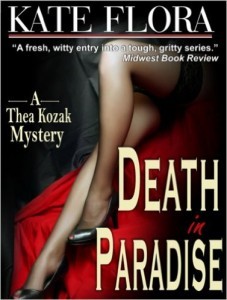Kathy Lynn Emerson's Blog, page 96
September 8, 2015
Watching the Sea is Noble Work
Kate Flora: It is a gift to have friends who are creative. They don’t just write good books
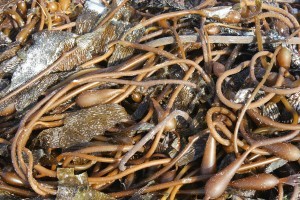
A sampling of what a writer sees
and poems or paint good pictures–they ask thoughtful questions and say interesting things. Once in a while, I find myself writing those things down to save for a day when I need an inspiration, or something to ponder on, or a blog topic. Those things used to go into a little notebook that I carried in my purse. More recently, though, they tend to get written down in the “notes” app on my iPhone or on my iPad. There they rest until I need them.
The title of today’s blog is a recent acquisition–I only acquired it two days ago. I was just back from vacation–a driving trip around Nova Scotia to sort of make up for having to cancel two weeks in Italy–and though I was home and work and the shiny new office beckoned, I didn’t want to leave the porch, or my rocking chair. I wanted to stare out at the sea and read a trash novel (is a novelist even allowed to say this, I wonder?) and just veg out until it was respectably late enough to long for a gin and tonic. In the wicked habit fallen into by those of us whose publishers have told us we “have” to be on Facebook, I posted my guilt about not working. And I got the line above in reply.

Sometimes the signs say it all. Or, as Craig Johnson says, stay calm, have courage, and wait for signs.
This post might really be about the importance of being in the world, and of carrying that little notebook to write down the things that happen around us. In my little notebook there are names, and instructions to myself, and to do lists, and lots of numbers, and books I should buy. But what is most fun are the odd things that are written there.
“Bee truck” reminds me of this: Two summers ago, my husband and I were driving up the Maine turnpike and we passed a truck loaded with small, square white boxes and draped in a lot of netting. As we passed, I could see that it was a massive load of bees bound for a blueberry field. And as we finished passing, I saw that the driver was texting. Since my mind is often in cop world, I said to my husband, “I’d hate to be the cop who rolled up on the scene if that thing has an accident.” The next year, I read in the paper that one such truck had tipped over in Baltimore.
If I scroll through the notes, I find things like this:
The empty channels through the salt marsh look like slick brown eels.

An odd thing to find deep in the forest?
Or this, though I don’t know what it means:
Driving around with skunks
A person is only as strong as their enemies.
The pain of being from away was a comment made by a writer who had moved to Maine and felt like an outsider.
And these: Decadence can’t be rushed. Rental caskets. There’s always a farmhouse. World’s largest marine taxidermist. No just any ooze. Fifty shades over fifty.
There is the thing a friend said, quite casually, one night at dinner: “Every time I got clam poisoning . . .” And from another friend, “I’ve come terms with the pickles.”
From a talk by James W. Hall:
Hide the word that is the subject of the book in the first paragraph
The experience is both “of course” and “aha!”

Just mossy tree roots or the strong toes of a lurking giant?
Weird word sequences like fuzzy logic, fussy logic, fluffy logic
There is a page of tee-shirt mottos for writers, including:
I’m a mystery author. I write wrongs.
Major Heroine Dealer
Is “Publishing Business” an oxymoron?
And of course: Living in Sue Grafton time–where no one ever gets old.
So, dear readers: Do you have a notebook? A stack of index cards? An entire bookshelf full of notebooks? A shoebox full of those little pieces of paper you’ve scribbled on? And will you share some of your notes with us?
September 7, 2015
Murder Without the Gore: Part III
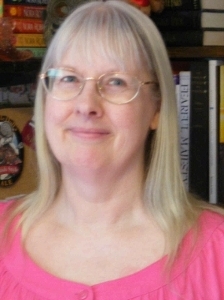 Kathy Lynn Emerson/Kaitlyn Dunnett here, finishing up my take on traditional (including cozy) mysteries. You can read part one here and part two here. This segment offers my (often highly opinionated) answers to some frequently asked questions.
Kathy Lynn Emerson/Kaitlyn Dunnett here, finishing up my take on traditional (including cozy) mysteries. You can read part one here and part two here. This segment offers my (often highly opinionated) answers to some frequently asked questions.
Why are traditional mysteries so popular?
Simple answer: they offer readers an escape from harsh reality. By the end of a traditional mystery, the crime has almost always been solved, the villain punished, and order restored. In addition, although there are some stand-alones, the majority of traditional mysteries are part of a series, which means readers become invested in the characters and how they develop from book to book.
What are editors looking for in the genre?
Here’s the annoying answer: The same only different. Since cozies are currently selling well, right now they want more cozies. They want something that hasn’t been done to death, but they don’t want to go too far out into left field. The result is that there isn’t just one quilting series. There are at least three. Instead of just one series set in a shop that sells Scottish imports—mine—as of this past spring there are two. Go figure.
Even more important, editors are looking for books with series potential, which means they feature characters that readers will want to revisit. Writers need to be able to come up with clever ideas for future books. Lately, there also seems to be a trend toward more frequent publication. It used to be that publishers didn’t want to bring out more than one book a year by the same author. Now series books, at least in paperback originals, are being scheduled every six months or so, which makes for a tight writing schedule for the author.
What are the taboos?
I’ve already mentioned some of these in part one, but it never hurts to reiterate. Sometimes it seems as if the traditional mystery, especially the cozies, are defined by negatives. No excessive gore or gratuitous sex or violence. Don’t kill an animal, especially a pet, especially a cat.
Frankly the most important “don’t” is don’t neglect your research. Don’t get details wrong. If a gun is fired, don’t have a character comment on the smell of cordite. Cordite hasn’t been used for decades. Whatever you might be smelling, that’s not it. Lee Lofland’s website, The Graveyard Shift, is a great place to go to find out some of the common errors writers make when it comes to anything to do with police procedure. Lee also runs the Writers Police Academy.
There are quite a few experts out there who enjoy helping writers get it right. Two more are Dr. Doug Lyle, who answers questions on medical matters, and the Poison Lady, Luci Zahray, who frequently attends mystery conferences and will happily tell you how to bump off your nearest and dearest with chemicals and plants.
Getting details right is even more important if you set your mystery in the past. Your editor may not know enough to catch an error, but you can be sure readers will. Again, there are experts to ask—and I don’t mean Wikipedia! Find them. There is no excuse for getting stuff wrong.
What makes one traditional mystery stand out from the rest?
The following tips are especially true if this is your first novel and if you are trying to sell to a traditional publisher. If you have a track record, you have a little more leeway, but not much.
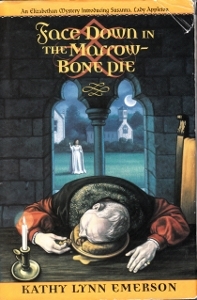 First tip: try to find a niche that hasn’t been done to death. This can be frustrating. I did my research back when I started my Face Down series. At that time, there were other mystery series with Elizabethan settings, but they were all set in the latter part of the reign of Elizabeth the First. Thinking I’d have the decade to myself, I set Face Down in the Marrow-Bone Pie in 1559. Apparently, other people had the same idea. Within a few months of each other, my book, the first book in Fiona Buckley’s Ursula Blanchard series, set in 1558, and the first book in Karen Harper’s series with Queen Elizabeth herself as the sleuth, set in 1558, all came out from different publishers.
First tip: try to find a niche that hasn’t been done to death. This can be frustrating. I did my research back when I started my Face Down series. At that time, there were other mystery series with Elizabethan settings, but they were all set in the latter part of the reign of Elizabeth the First. Thinking I’d have the decade to myself, I set Face Down in the Marrow-Bone Pie in 1559. Apparently, other people had the same idea. Within a few months of each other, my book, the first book in Fiona Buckley’s Ursula Blanchard series, set in 1558, and the first book in Karen Harper’s series with Queen Elizabeth herself as the sleuth, set in 1558, all came out from different publishers.
Second tip: avoid areas that are widely perceived as not selling well, such as the American Revolution for historical novels—this is especially true if you want to sell to New York. Sad to say, some publishing houses have preconceived notions about certain settings or subjects. How do you figure out where these negative vibes live? You’re already looking at what’s out there—where are the gaps? Why are they there? How many series have tried to fill them and been cancelled after two or three books?
On the other hand, if there is a setting or situation you love and New York just isn’t interested, there are alternatives. Small, and not-so-small presses elsewhere don’t offer large advances, but they are more likely to take chances. There’s also Indie Publishing. There are ebook originals. Personally I’d advice trying the traditional route first, but in many ways there has never been a better time for writers who want to get their work out to the reading public.
Third tip: create an engaging—which is not the same as likeable—sleuth who is not a carbon copy of every other traditional detective, without going so far into left field that no one wants to take a risk. You want readers to come back. To use an example from TV, House could sustain a series. An attempt to imitate his caustic personality probably can’t.
Fourth tip: come up with a marketing plan to go with your proposal. Lea Wait has already covered this territory here at Maine Crime Writers with “Marketing and Competitive Research Before You Write.”
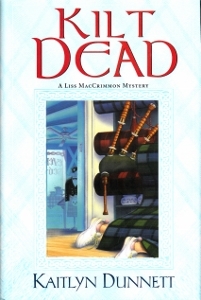 Do you need a hook to make a sale?
Do you need a hook to make a sale?
It couldn’t hurt. In a way, this is an extension of the last question. Stand out. Catch the editor’s attention, then fill in details. Think in terms of a movie pitch—short and kicky. Or maybe the title can say it all. When I first told my agent my ideas for what became the Liss MacCrimmon series, she wasn’t that thrilled with a lot of the details (and I ended up changing many of them) but the title, Kilt Dead, struck a chord. She said, and I’m quoting, “I can sell it on that title.”
And speaking of titles—What’s with all the puns?
I’m talking mostly about cozies here. Some of the puns are pretty awful. But this trend grew out of something that actually makes sense. You want to have memorable titles and, if you’re writing a series, it’s helpful in building readership to have titles that tie together in some way. This is also called branding.
Most of the Liss MacCrimmon titles have something Scottish in them, since she runs a shop that sells Scottish imports. Kilt Dead, Scone Cold Dead, A Wee Christmas Homicide, The Corpse Wore Tartan, Scotched, and so on. Some are better than others. Some titles that I came up with, like Homicide with Haggis and Auld Lang Crime, were nixed by the publisher’s marketing department for reasons that, frankly, elude me. The publisher, however, has the final say on titles, just as they do on cover art.
Do you need a title with a pun in it if you’re writing on the cozy end of traditional? Not necessarily a pun, but connections between titles in a series are definitely a plus. Some writers have used song or movie titles on books in a series, or variations on them. A series about a librarian by Miranda James includes File M for Murder, The Silence of the Library, and Arsenic and Old Books. Barb Ross has used Clammed Up, Boiled Over, and Mussled Out for her Maine Clambake series. Lea Wait’s Mainely Needlepoint titles are Twisted Threads, Threads of Evidence, and Thread and Gone. Ella Barrick has a three-book series about a ballroom dance instructor. The titles are Quickstep for Murder, Dead Man Waltzing, and Homicide Hustle. And my personal favorites come from a paranormal mystery series written by Laura Resnick. They include Doppelgangster, Polterheist, and Abracadaver.
Obviously, there’s a fine line between clever wordplay and a real groaner. I won’t diss fellow writers by sharing titles I think are awful. I’m sure you can think of those for yourself. Please, don’t share them. But if you are so inclined, I’d love to hear some of your favorite mystery titles and the answer to this question: have you ever bought a book based on the title (or the cover art) alone?
Kathy Lynn Emerson/Kaitlyn Dunnett is the author of over fifty books written under several names. She won the Agatha Award in 2008 for best mystery nonfiction for How to Write Killer Historical Mysteries and was an Agatha Award finalist in 2014 in the best mystery short story category for “The Blessing Witch.” Currently she writes the contemporary Liss MacCrimmon Mysteries (The Scottie Barked at Midnight) as Kaitlyn and the historical Mistress Jaffrey Mysteries as Kathy (Murder in the Merchant’s Hall). The latter series is a spin-off from her earlier “Face Down” series and is set in Elizabethan England. Her websites are www.KaitlynDunnett.com and www.KathyLynnEmerson.com
September 6, 2015
Our Garden Plot
Hi! Kate here, coming to you over the airwaves while at vacation. At Maine Crime Writers, we’re happy to share another guest post from our friends at Mainely Murders Bookstore today. Hope you’ve had a chance to visit them this summer…or will this fall. And if you have a chance, go to their website (link below) and sign up for their terrific newsletter.
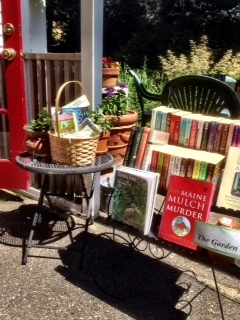 Summer visitors to Mainely Murders Bookstore in downtown Kennebunk know we have a garden plot—albeit, much overgrown—but one we think is a perfect place to hide the body. That’s why, each year, we highlight mysteries set in gardens.
Summer visitors to Mainely Murders Bookstore in downtown Kennebunk know we have a garden plot—albeit, much overgrown—but one we think is a perfect place to hide the body. That’s why, each year, we highlight mysteries set in gardens.
We like the names of the books—titles like Thyme of Death, Deadly Slipper, The Azalea Assault, Slay It with Flowers, Gardens of Secrets Past, Slugfest, Three Dirty Women, and Death in the Garden.
Many are from today’s crop (no pun intended) of writers of cozies. Most are set in the U.S., but some are set outside the country, often in England.
But there’s nothing new about garden-themed mysteries. Obviously, we’re not the only ones who see the possibilities for murder weapons and burial sites. But, the writer who really set the tone for “murder in the garden” was Ireland’s Sheila Pim, who between 1945 and the early 50s, wrote titles like Common or Garden Crime, Creeping Venom, A Brush with Death, and A Hive of Suspects to entertain her father, who loved mysteries.
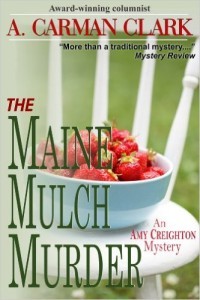 But, here at Mainely Murders, our best selling “garden-variety” murder is from much closer to home, the ever-popular The Maine Mulch Murder (2001), written by the late A. Carmen Clark—mother of our very own Kate Flora and John Clark. Evidently, interest in mysteries (and murder) run in that family.
But, here at Mainely Murders, our best selling “garden-variety” murder is from much closer to home, the ever-popular The Maine Mulch Murder (2001), written by the late A. Carmen Clark—mother of our very own Kate Flora and John Clark. Evidently, interest in mysteries (and murder) run in that family.
I never met Mrs. Clark. But The Maine Mulch Murder, now out of print, has long been a favorite of mine. Maybe it’s because, although we have a lovely small garden outside our Kennebunk home and bookstore, gardens have always held a sense of danger for me. All those bees flying around. And, I can’t tell you how often I’ve stumbled into a hole dug by some creature, obviously out there to do no good.
 But The Maine Mulch Murder has retained its innocence. After all, like all the books in our shop, the murder and havoc wrecked upon the small town of Granton, Maine, is pure fiction. And, talk about innocent, it was dreamed up by a sweet little old lady (she was 83 when it was published), when she tired of writing garden news for the local Camden newspaper.
But The Maine Mulch Murder has retained its innocence. After all, like all the books in our shop, the murder and havoc wrecked upon the small town of Granton, Maine, is pure fiction. And, talk about innocent, it was dreamed up by a sweet little old lady (she was 83 when it was published), when she tired of writing garden news for the local Camden newspaper.
So, this summer, as I’ve done every summer since we opened our bookstore five years ago, I set about creating our Garden Plot of garden-themed mysteries. On dry, sunny days, it’s just outside our front door; rainy days send the display indoors. There, front and center, I place The Maine Mulch Murder—and replace it and replace it. It never lasts long on the shelf.
 Because we principally sell used books, we’re always on the lookout for copies at library book sales, garage sales, even the dreaded internet. But, still we run out.
Because we principally sell used books, we’re always on the lookout for copies at library book sales, garage sales, even the dreaded internet. But, still we run out.
This year, I e-mailed Kate, telling her how very much I’d always enjoyed her mother’s book, and that it was very popular at Mainely Murders. She seemed pleased and said she believed her mother, who died in 2005, would be happy that a few people were still reading her book.
“No, no,” I said. “A lot of people are enjoying it and, in fact, The Maine Mulch Murder is, year in and year out, a steady seller. We can never get enough copies to satisfy demand.”
 When she told me she might have a few copies around her home, I was elated and asked if I could buy them from her. She e-mailed me back, “Found ‘em. Would you like two or twenty?”
When she told me she might have a few copies around her home, I was elated and asked if I could buy them from her. She e-mailed me back, “Found ‘em. Would you like two or twenty?”
Needless to say, I pounced on the 20. (In truth, she could fit only 18 in the box she shipped to me. But I have my eyes on those two left behind.)
So now, when customers, quite often vacationing from away, spot the book’s bright red cover, emblazoned with the title, and reach for it at the same time, I needn’t worry breaking up a tug-of-war. For a little while now, I can let them both have it.
Paula Keeney, along with partner Ann Whetstone, owns Mainely Murders Bookstore ( www.mainelymurders.com ) at 1 Bourne Street, Kennebunk. While she claims to be a little afraid of their garden, it was the setting for their wedding three years ago. She says the bookstore was too small.
September 4, 2015
Weekend Update: September 5-6, 2015
 Next week at Maine Crime Writers there will be a guest post from Mainely Murders on Monday followed by posts by Kathy Lynn Emerson/Kaitlyn Dunnett (Tuesday), Kate Flora (Wednesday), John Clark (Thursday) and Dorothy Cannell (Friday).
Next week at Maine Crime Writers there will be a guest post from Mainely Murders on Monday followed by posts by Kathy Lynn Emerson/Kaitlyn Dunnett (Tuesday), Kate Flora (Wednesday), John Clark (Thursday) and Dorothy Cannell (Friday).
In the news department, here’s what’s happening with some of us who blog regularly at Maine Crime Writers:
from Kathy Lynn Emerson/Kaitlyn Dunnett: I’ll be speaking and signing books at Curtis Memorial Library in Brunswick, Maine on Tuesday, September 8 from 7-8 PM as part of the Mystery Author Series. The event is held in the Morrell Meeting Room and there will be refreshments provided by Bohemian Coffee House. Books are supplied by Gulf of Maine Books. Also, don’t forget that if you are on Goodreads you can enter a giveaway for advance reading copies of the next Liss MacCrimmon adventure, The Scottie Barked at Midnight. The giveaway is at https://www.goodreads.com/giveaway/show/151622-the-scottie-barked-at-midnight and runs until September 14.
Murder by the Book is coming up September 18 and 19 at Jesup Memorial Library. Current Maine Crime Writers Brenda Buchanan, Dorothy Cannell, Kate Flora, Vaughn Hardacker, Chris Holm, Maureen Milliken and Lea Wait will be among the authors speaking and signing there. So will alums Gerry Boyle, Paul Doiron and Julia Spencer-Fleming. Click on the link above for details.
An invitation to readers of this blog: Do you have news relating to Maine, Crime, or Writing? We’d love to hear from you. Just comment below to share.
And a reminder: If your library, school, or organization is looking for a speaker, we are often available to talk about the writing process, research, where we get our ideas, and other mysteries of the business. Contact Kate Flora: mailto: kateflora@gmail.com
September 3, 2015
The 2015 Cover Controversy!
Vaughn Hardacker here. Last month my publisher, Skyhorse Publishing, forwarded me the proposed cover for my novel THE BLACK ORCHID, slated for release on March 1, 2016. My first impression was: “Wow, what a great cover!” Then I wondered if the story included enough sex to warrant the cover. Nevertheless, I rushed out to post the cover for the world to see on Facebook, Twitter, and Google+. In no time the comments came rolling in–every one positive. My agent thought it was quite risqué and possibly it indicated more sexual content than was in the novel (see my reservation above), but it was reminiscent of the noir covers popular in the 1950s and 1960s. We both agreed that if nothing else it would be eye-catching.
Then I got a comment from our own Kate Flora: “Nice cover…I think I’ve seen those legs before.” I assumed Kate was making a joke and didn’t think about it again. Then I got an email from Kate saying “…check out the following link” followed by a link to amazon.com. I followed the link and here’s what I saw!
I immediately spoke with my agency (Talcott Notch Literary Services) and Gina Panetteiri, President and founder, explained that publishers often purchase the rights to artwork from agencies, they then obtain the right to change it to suit their needs. She went on to say that it is not uncommon for this situation to arise.
I then contacted the publisher and sent them a copy of the link and they informed me that they would redo the cover. The irony of this situation is that Kate and I are represented by the same agent and she recently signed a publication contract with the very same publisher for her book, A Good Man with a Dog. While similar covers may not be a major issue, I wondered what the effect might be if the two authors were with the same publishing house (although the books are with different houses and Kate’s book was released in 2011 as the fifth of her Thea Kozak series).
I think this must be one of those psychic events we often hear about. If Kate and I were not personal friends (both in life and online) and if we were not colleagues this might have gone unnoticed. But what is the probability that two authors in the same publishing house and represented by the same agent would have books utilizing the same cover artwork!
So, now I’m waiting for the publisher to redo the cover so I can send out a correction post along with the new cover.
You will never guess what’s on Amazon though–yup the duplicated cover!
September 2, 2015
A Family Reunion in Maine
Hi. Barb here, less than a week before I leave Maine for the season. (Sniff.)
I come from a tiny family. My father was an only child as were both my grandfathers. My mother had one sister who had three children, my only first cousins. My mother had two first cousins, my father had three. I have one brother.

The cousins: Front row l-r: Bobby, Rip, Bill, Back row: Barbara Jean, Barb, Linda. Unconsciously, each guy sat in front of his sister.
Compare that to my husband, who had twenty-eight first cousins and five siblings. No wonder it took me a little while to adjust to his family gatherings.
So a tiny family. Add to that I grew up on the east coast, and my cousins in Chicago. It’s not like we never saw one another. My cousins made several trips to Jersey shore with my aunt and uncle to spend a week in Sea Girt with my grandparents. I remember when I was first married, my aunt and uncle brought my cousin Bill to Boston to see Carlton Fisk catch at Fenway Park. And when she was in graduate school, my cousin Linda visited with her boyfriend and somehow left engaged. I was never sure if her husband planned that all along, or whether after a dozen terrifying trips up and down the Jamaicaway trying to find our house in West Roxbury, they decided to cling together for the rest of their lives, which would have been an understandable reaction.
I was closer to my mom’s cousins, who were much nearer in age to me than they were to Mom. I call them Bobby and Barbara Jean, though the rest of the universe knows them as Rob and Barb. Bobby is eight years older than me and joined the U.S. Navy when he was nineteen, so to me he was the glamorous grown-up cousin, off in exotic places. But Barbara Jean, only four years older, spent many happy weeks over several years with my brother Rip and me in Sea Girt. She was the one who talked to me about teenager stuff like dating and dances. As the older child in my nuclear family, I’d have no idea about popular music before the Beatles if it weren’t for Barbara. But thanks to her, I can sing along to the entire score of Jersey Boys.
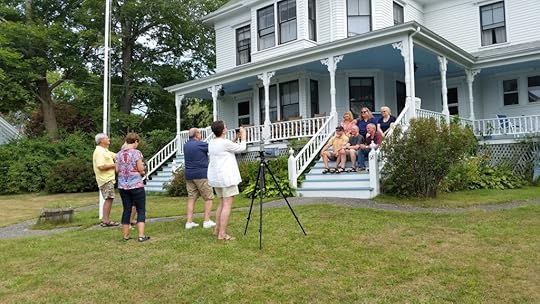
The outlaws pap the cousins.
During the adult years of kids and careers and craziness, we didn’t see much of one another. But then we didn’t need to. We had our moms, who kept up on the telephone and let us know what was going on in one anothers’ lives. Mostly, it was the mother-approved, upbeat, happy version, but we also knew about some of the pain and struggles.
Then, slowly, we lost that generation. And we could have just as easily lost one another.
When my mom died, my cousin Bill, who’d grown close to her, really wanted to come to her memorial. I held him off. We’re WASPs, and for us these events are stiff-upper-lipped affairs that you white-knuckle through and forget as quickly as possible. I wanted to see Bill when I’d have time to talk to him and not be dealing with my children’s grief at losing their grandparent or the sadness of my mother’s friends. So I promised we would get together.
The following winter, I realized Bobbie and his wife and Barbara Jean and her husband were in Venice, Florida, and my husband Bill and I were in Key West. Was that enough critical mass to attract the others?
I sent out an e-mail, proposing a date when Bill and I would be driving north from Key West. My cousin Barbara remembers thinking, “This will never work. No way all these people’s schedules fit together.” But slowly and amazingly, the responses rolled in. “Yes” “yes” and “yes.” Everyone but my cousin Susie could make it. Six cousins and their spouses got together in Florida and had a roaring good time. Such a good time, we vowed to get together again.
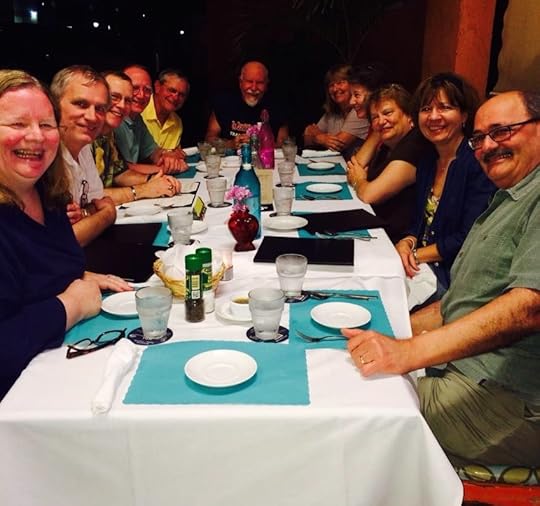
2014 the cousins and spouses in Venice, Florida
And we did, last weekend at our house in Boothbay Harbor, Maine. We talked and we ate and we adventured and then we talked and ate some more. Bobby’s wife Jan calculated that among the twelve of us, we represented 225 years of marriage, so by this point the spouses have long, shared experience with the family stories, too. We looked at black and white photos on which my grandmother had helpfully noted things such as, “you can see the back of Rip’s head,” without a word about who you could actually see in the photo, or what the date, place, or occasion was. I lobbied for “someone” to take up genealogy, but so far, no takers.
It was all so easy and fun we started talking about “next time,” maybe in the midwest so Susie can at last join us.
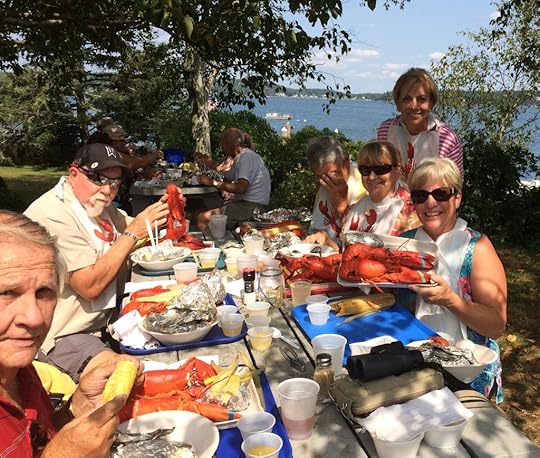
Of course, some cousins and friends had to go to the Cabbage Island Clambake, inspiration for my Maine Clambake Mystery novels.
We’re older now. Six of the twelve of us are retired. Only one couple still has a kid at home, and we have a little money in our pockets, so flights to visit family are a much more realistic possibility. But you hafta wanna.
My aunt Carol died last fall, so the last tie between us has been broken, unless we forge our own. We could easily become strangers whose children and grandchildren, weirdly, and for no reason they understand, all make the same potato salad and gingersnaps for family gatherings. But I hope that doesn’t happen. When you become the generation at the edge, there is something wonderful about being with the only people in the world who know where those recipes came from.
Readers, how about you? Family reunions? Yes, no, maybe?
September 1, 2015
September Beginnings
Lea Wait, here.
To me, September has always meant “begin again.” From pre-kindergarten through college, it was the time school started. (I still can’t get used to schools starting in August, which they do for my grandchildren in Virginia and Kansas.) 
September is the time to buy notebooks. Pencils. Pens. Composition books. Assignment notebooks. Everything new, pristine, and full of promise. This year grades would be higher. Friends would be closer. Teachers would be more inspiring. In short: a time of hope.
I still get an unreasonable thrill going to office supply stores and searching the aisles for the perfect notebooks, pads, writing implements, calendars, mailing envelopes … all the tools of the writers’ trade. I know buying elastic bands and staples and padded envelopes and pads of paper shouldn’t make my heart beat faster. But does.
I’m choosing the tools that, this time, will ensure that my next manuscript will be stronger. My perpetual “to do” list will be completed. My files will be neater.
Ultimately, that I will, this time, be a better, more whole person. More efficient. More organized. More productive. And, ultimately, somehow, life will be better.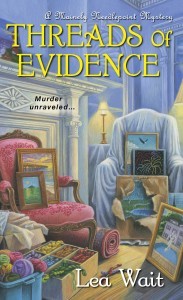
Yes. When it comes to office supplies (aka school supplies) I am completely delusional.
But now it’s happening again. It’s early September. Last week the latest in my Mainely Needlepoint series, Threads of Evidence, was published. Yesterday I put the manuscript of my next Shadows Antique Print mystery series, Shadows on a Morning in Maine, in the mail to my editor.
Today I’m going to go through the rite of organization: clean out my desk drawers and in-box. Sharpen my pencils. File my notes for Morning in Maine. And get out notes for my next project.
I know what it’s going to be. I have a folder of ideas and a pile of reference books to be checked. It’s in a genre I’ve never tried before, and that’s exciting. And I have only a couple of weeks to test out the possibility … after that I’ll have to work on my next manuscript, due December 1.
But I’m giving myself two weeks to begin again. Try something new.
I hope it works.
And if it doesn’t … I’ll put it away for another day, and start on a new mystery.
Because September is a time for beginnings.
Lea Wait is the author of the 7-book Shadows Antique Print Mystery Series, the latest of which is Shadows on a Maine Christmas, and the Mainely Needlepoint series, Twisted Threads and Threads of Evidence. She’s also written a series of essays about Maine and writing, Living and Writing on the Coast of Maine, and five historical novels for ages 8 and up. She invites readers to friend her on Facebook and Goodreads.
August 31, 2015
Being Published
Our guest today is Detective Sergeant Bruce Coffin, who retired a while back from the Portland police department and has now embarked on the task of writing crime instead of fighting crime.
Bruce Coffin: The other day someone asked what it felt like to have one of my stories 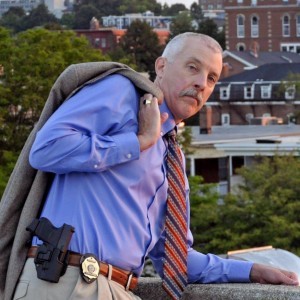 published. I told them it felt great. Of course. What else would I have said? My answer was short and direct, although as I think back on that moment, not entirely truthful. The truth is beyond words.
published. I told them it felt great. Of course. What else would I have said? My answer was short and direct, although as I think back on that moment, not entirely truthful. The truth is beyond words.
My writer friends have been a constant source of encouragement. Saying things like, “don’t worry it will happen,” and, “your writing is good, it’s just a matter of time.” But as the years passed I began to wonder. Do I really have what it takes to break through the barrier? The unpublished writer’s corner? I wondered…
In spite of the ever present specter of doubt, I worked hard on rewriting and re-editing my first novel, crafting new short stories and rewriting and re-editing those, again and again. I had trusted friends and relatives read my work and offer their opinions and advice. I continued to enter contests and submit my work to publishers and agents. And I continued to add to my collection of rejection e-mails.
If you’ve never received one, I can tell you first hand that notices of rejection from the publishing world are funny things. They look suspiciously like dear John letters. Designed to soften the blow, they say things like, “We thoroughly enjoyed your story,” or “your work shows real promise.” Well written and pleasant, but rejections just the same. As painful and heartbreaking as if they’d come from an ex-girlfriend to someone actually named John.
You can drive yourself crazy. I reacted differently each time I received a rejection. Sometimes I’d feel depressed. Other times I’d be angry. Pissed that they’d failed to recognized the brilliance in my writing. I thought, what possible story could someone have penned that was better than the one I’d submitted? Jeesh. But then I’d take a step back. Eventually, reading the work of the writers they did publish. Wow, I’d think. That story really was better than mine. I’d love to write a story that good. Then I’d look at the rejection e-mail again. It wasn’t so bad after all. Maybe they really did like my story.
So, I climbed back into the saddle of my trusted stead (my IPad), vowing to continue my quest. To push on toward that holy grail of publication. Being able to hold my head up high as I walked among the published writers, knowing I belonged. That I was one of them. From that day forward whenever someone I’d just met asked what I did, and I answered that I was a writer, I could mean it. When they asked the enviable follow-up question, where can I find your work? No longer would I have to mumble, oh, I’m not published yet, before slithering away to some dark corner in search of alcohol or a high ledge. I’d be able to actually tell them! Maybe they’ll want a signed copy of my work? Sure, I’ll say. Happy to do it. Who should I make this out to?

Doesn’t this guy look happy!!!
The truth is, when I awoke on that memorable Tuesday morning and checked my email, I couldn’t believe what I was seeing. The word congratulations hung there on the screen. Surely this must be spam that made its way into my inbox. Who else begins an email with congratulations? Certainly not a publisher. Obviously, In my pre-coffee state I was hallucinating. The SPAM must have been right next to another rejection email and I’d jumbled the words together in my mind. I was sure that when I looked back the email would tell me that I’d won a free four day trip to the Caribbean, or maybe a surprise gift, all of which would only cost me three easy payments of $79.99.
I rubbed my eyes and looked again. Congratulations. It really was from a publisher. I jumped out of bed and did a short awkward version of the Snoopy dance. Thankfully, there were no witnesses. I went and found my wife in the next room. Wanting to appear nonchalant, I tried to calm myself. When I told her the news, she let out a squeal of delight. I think I may have let out a squeal myself. I was over the moon. Giddy with excitement. Insert any other tired cliché for thrilled that you can think of, here.
Time has passed. I’ve read that email at least a hundred times. Shared the news with others and tried to get a handle on the idea of finally getting published. What does it mean? What it means is working harder. Writing more and honing my craft. In the past week I’ve penned a new short story and returned to the task of re-editing my first novel. Neither of which feels like a burden any longer. Now that I’m a published writer.
Now, if you’ll pardon me, this newly published writer has a lawn to mow.
Appalachian Trail is suddenly the place to be (theoretically)
Maureen Milliken here…
Remember back in 2009, North Carolina governor Mark Sanford’s alibi for an extramarital affair with a woman in Argentina was that he was hiking the Appalachian Trail?
Sanford was away from home for about a week, but events overtook him and the alibi didn’t hold up.
And the Appalachian Trail, briefly at least, became part of a bad punchline.
Until then, not that the trail was unheard of, but it wasn’t really in the news a lot. There’d be brief mentions here and there, but it was just there. Someplace, for most of us, other people went to hike.
Not this summer though. I’m going to dub this The Summer of the Appalachian Trail.
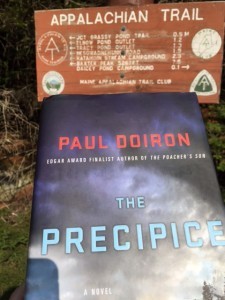
Paul Doiron’s “The Precipice” is one of many reasons the Appalachian Trail is getting a lot of attention this summer.
A lot of the credit goes to Maine crime writer Paul Doirin, who’s sixth Mike Bowditch novel, “The Precipice,” was released at the beginning of the summer and the trail plays a big part.
Hollywood has also remade the Bill Bryson classic “A Walk in the Woods,” with Robert Redford playing the Bryson character. The movie comes out next weekend. If you’ve never read the book, it’s as harrowing as Doiron’s in its own way as Bryson and another horrifically unprepared friend hike the trail from Georgia to Maine.
The movie is getting a lot of buzz, and no one seems too bothered that 79-year-old Redford is playing the role of Bryson, who was 44 when he hiked the trail in 1996. Bryson, least of all. Though if Robert Redford were turning my book into a movie, I probably wouldn’t have any gripes either.
Nick Nolte, 74, is playing his friend, Steve Katz. And of course, because it’s Hollywood, 56-year-old Emma Thompson is playing Redford’s wife. I guess I’d look kind of jerky if I pointed out that Bryson’s wife would have had to be 21 for that to match, but I guess I should just be grateful Hollywood, which can’t conceive of men over 30 actually being paired with women their own age, didn’t give Redford a 21-year-old wife. I guess he wouldn’t be out on the Appalachian Trail if that were the case. But I digress.
This morning’s Kennebec Journal and Morning Sentinel, as well as other Maine newspapers, carries an Associated Press story about hikers trashing the trail, drinking, crowding it out. Kind of the latest Mount Everest.
The story speculates that the movie “Wild” about a troubled woman hiking the Pacific Rim trail led to the resurgence and speculate “A Walk in the Woods” is going to make it worse.
The AP story says that more than 830 people completed the 2,189-mile hike last year, up from just 182 in 1990, according to the Appalachian Trail Conservancy. At Baxter State Park, the north terminus of the trail, the number of registered long-distance hikers grew from 359 in 1991 to more than 2,000 in 2014.
So fame has its downside. Funny as an affair alibi, it’s now become a bucket list must-do for, I guess, people who like to party and throw trash around.
It’s getting bad enough that Baxter State Park officials are threatening to have the last miles of the trail and it’s famous end moved from the park and the summit of Mount Katahdin.
The reality of the trail, as Bryson so effectively spells out, is not as a party spot.
Doiron’s book, while fiction, is also a reminder that the trail is remote, it’s dangerous and it shouldn’t be taken lightly. Doiron told the Boston Globe in an interview published in Sunday’s paper that a harrowing event on the trail when he was 22 changed his life and informed his fiction
He and two friends were hiking the trail in 1988 when they were struck by lightning and one of them was critically injured.
“It was the longest night of my life and my first brush with mortality,” Doiron told the Globe. “In my books now I write about the need for humans to be humble before the power of nature. I learned that lesson when I was 22 on the Appalachian Trail.”
Two years ago, Geraldine Largay’s disappearance on the trail, brought it onto the front pages of newspapers. The Tennessee woman, a thru-hiker, vanished without a trace in Franklin County here in Maine as she neared the last hundred or so miles of her hike. She has yet to be found.
Largay was hiking through what’s considered the toughest and most dangerous section of the trail’s 2,000-plus miles. Despite intensive and repeated searches, they have yet to find even her backpack. No, it’s not to be taken lightly.
My guess is that once movies that have made college kids and rich bucket-list people think the trail is something they just have to do fade back a little, the trail will get back to normal.
But the things that make it so compelling — to the brave few who understand it and hike it because of that, and the rest of us who settle for reading about it — will always remain.
Maureen Milliken is the author of Cold Hard News, the first in the Bernie O’Dea mystery series.
August 28, 2015
Weekend Update: August 29-30, 2015
 Next week at Maine Crime Writers there will be posts by Maureen Milliken (Monday), Lea Wait (Wednesday), Barb Ross (Thursday) and Vaughn Hardacker (Friday) with a special guest post by Bruce Coffin on Tuesday.
Next week at Maine Crime Writers there will be posts by Maureen Milliken (Monday), Lea Wait (Wednesday), Barb Ross (Thursday) and Vaughn Hardacker (Friday) with a special guest post by Bruce Coffin on Tuesday.
In the news department, here’s what’s happening with some of us who blog regularly at Maine Crime Writers:
Check this out. Many of us are planning to attend Murder By The Book in Bar Harbor Friday, September 18 and Saturday, September 19 and you can be there, too. Get your tickets now!
Lea Wait: On Sunday, August 30, I’ll be interviewed by host Harry Rinker of “What’ve You Got?” a nationally syndicated radio equivalent of Antiques Road Show. To check when the show airs in your city, check Harry’s website.
Kaitlyn Dunnett/Kathy Lynn Emerson: If you’re on Goodreads, starting August 31st you can enter a giveaway for advance reading copies of the next Liss MacCrimmon mystery, The Scottie Barked at Midnight. Number nine in the series, it will be in stores October 27th. Also, the trade paperback edition of the first in the Mistress Jaffrey series, Murder in the Queen’s Wardrobe, will be available in the U.S. on Tuesday, September 1st. The second Mistress Jaffrey Mystery, Murder in the Merchant’s Hall is already out in the UK. Publication date in the U.S. for both the hardcover and the ebook is December 1st.
An invitation to readers of this blog: Do you have news relating to Maine, Crime, or Writing? We’d love to hear from you. Just comment below to share.
And a reminder: If your library, school, or organization is looking for a speaker, we are often available to talk about the writing process, research, where we get our ideas, and other mysteries of the business. Contact Kate Flora: mailto: kateflora@gmail.com



